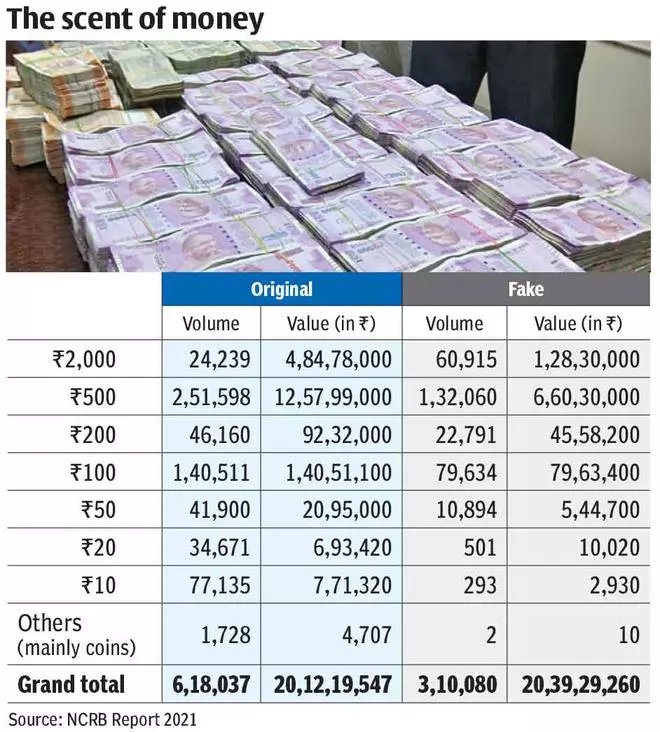(MAILING TABLE SEPERATELY)
The seizure of fake Indian currency in 2021 dropped to one-third of that in 2020. However, it was still higher than that in 2018 and 2019, data from the National Crime Record Bureau (NCRB) shows. While no reason was given for the drop in seizures, increasing use of digital means is believed to have led to the drop in the number of fake notes in circulation.
The maximum seizure of original or fake currency was of currency notes in the denomination of Rs 500. Data also shows that seizure of original currency notes has seen a downward moderation.
The NCRB’s report shows that the seizure of fake currency dropped to 3.10 lakh in 2021 from 8.34 lakh in 2020. In value terms it declined to Rs 20.39 lakh crore , as against Rs 92.17 lakh crore in the period. The year of the pandemic, 2020, saw a record increase in seizure of Fake Indian Currency Notes (FICN) at 8,34,947 notes worth ₹ 92,17,80,480 , as compared to 2,87,404 notes worth ₹ 25,39,09,130 in 2019, a 190.5 per cent increase.
Also read:Rise seen in counterfeits along with currency notes in circulation: Official data
Seizure of original notes
Providing details about the seizure of original notes, the NCRB report shows that the number of pieces dropped to 6.18 lakh from 6.19 lakh. In value terms, it dropped to Rs 20.12 crore in 2021 from 24.67 crore in 2020.

Earlier, two separate questions raised in the Lok Sabha during the monsoon session using data from the RBI and NCRB report of 2020, indicates an increase in currency notes in circulation. RBI data shows the volume of notes in circulation rose to 13,053.3 crore pieces from 9,026.6 crore between March 2016 and March 2022. Similarly, the value went up to Rs 31.05 lakh crore from Rs 16.41 lakh crore.
Another dataset from RBI shows that during 2021-22 as compared to the previous year, there was an increase of 16.4 per cent, 16.5 per cent, 11.7 per cent, 101.9 per cent and 54.6 per cent of counterfeit notes in the denomination of Rs 10, Rs 20, Rs 200, Rs 500 (new design) and Rs 2000, respectively. Seizure of counterfeit notes of Rs 50 and Rs 100 denomination declined by 28.7 per cent and 16.7 per cent, respectively.
“Banknotes of denomination Rs 500 (old & new notes) have the maximum number of counterfeit notes among these currency notes,” Minister of State in the Finance Ministry, Pankaj Chaudhary, had said in a response to a question in the Lok Sabha during the monsoon session. This remark runs contrary to what both the Government and RBI have maintained that new notes have strong security features.
However, Chaudhary also said: “More than 90 per cent of the counterfeit notes were of low quality and none of the major security features were compromised.” Both the government and the central bank say enhancing the security feature is a continuous process. In fact, in its annual report for FY 22, RBI said its agenda includes the ‘Establishment of a state-of-the-art facility for conducting cutting edge research to test the robustness of security features of banknotes and introduction of new security features,” as part of its Medium-term Strategy Framework, better known as ‘Utkarsh’.





Comments
Comments have to be in English, and in full sentences. They cannot be abusive or personal. Please abide by our community guidelines for posting your comments.
We have migrated to a new commenting platform. If you are already a registered user of TheHindu Businessline and logged in, you may continue to engage with our articles. If you do not have an account please register and login to post comments. Users can access their older comments by logging into their accounts on Vuukle.